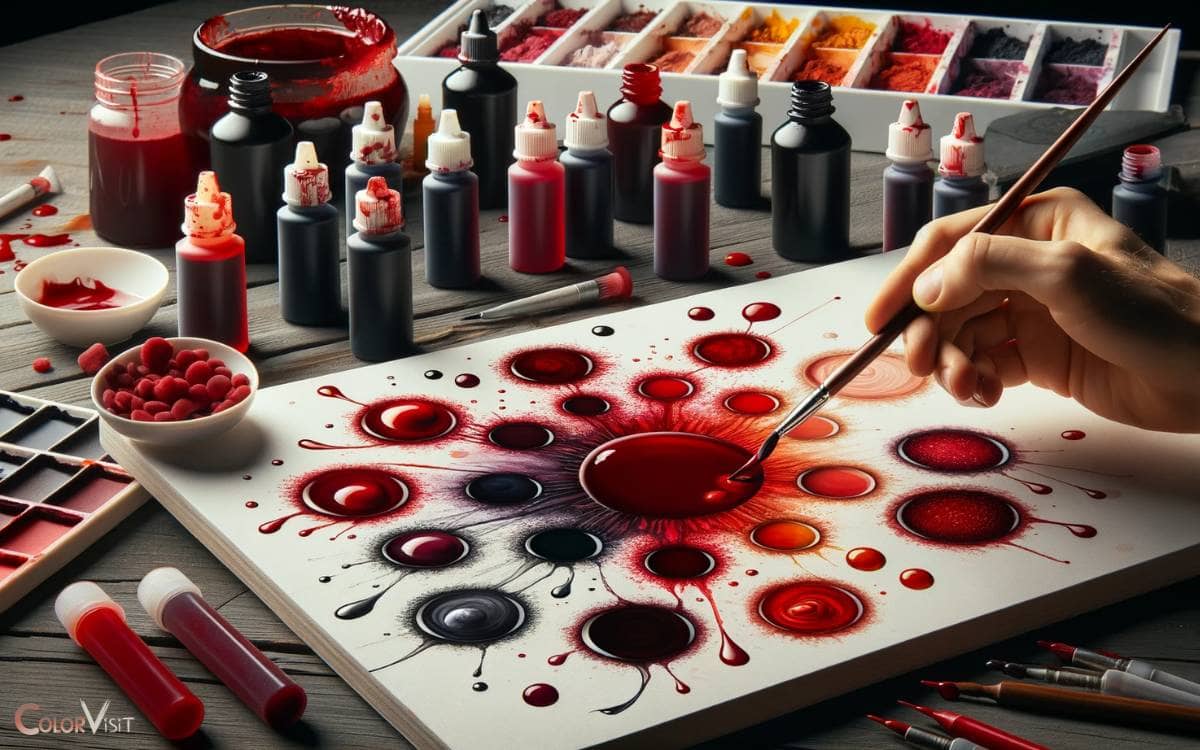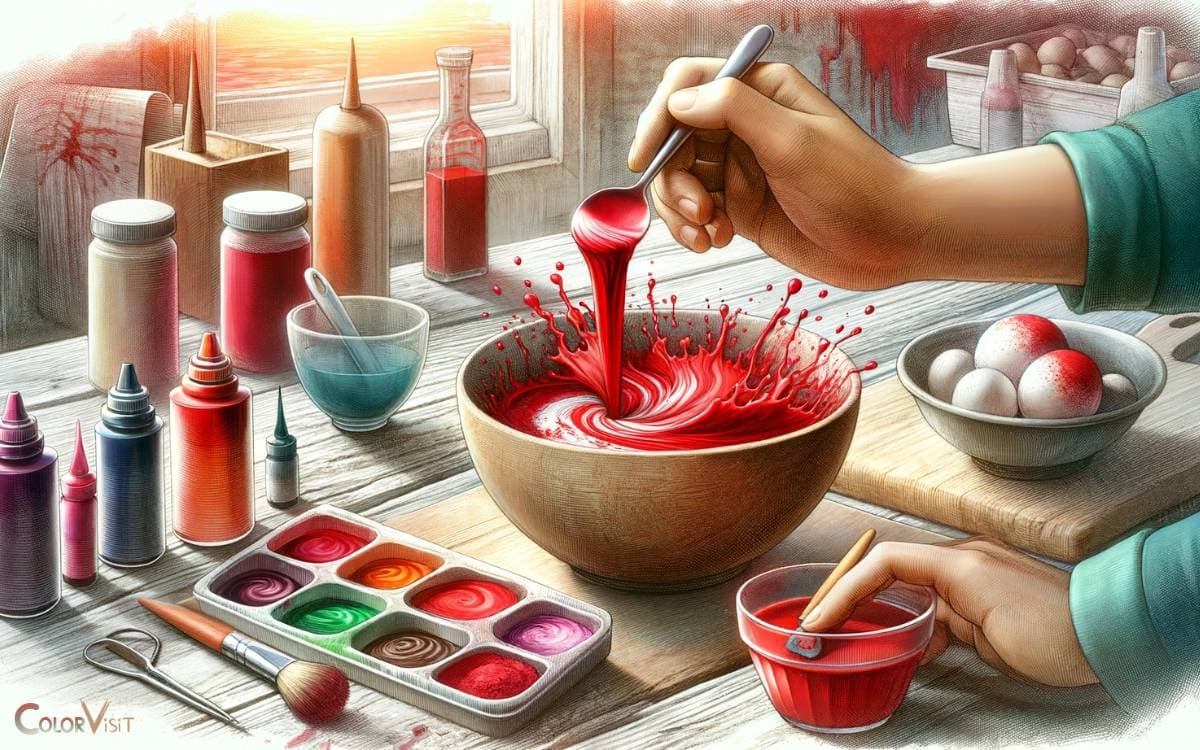How to Make Blood Red with Food Coloring? 4 Steps!
To create a blood red color with food coloring, start by adding drops of red food coloring to a base (such as frosting, icing, or fondant). To achieve a deeper hue, mix in a tiny amount of blue food coloring until you reach the desired shade. If you want a different color, learn how to make hot pink icing by blending red food coloring with a small amount of white icing to brighten it up. Adjust the quantities gradually to get the perfect pink you desire.
The process of making blood red with food coloring involves understanding color theory and how different hues interact.
Here’s a simplified example:
Perfecting the shade of blood red can be key for themed desserts, Halloween treats, or dramatic culinary presentations. Mastering this technique adds an impressive touch to your edible creations.
Key Takeaway
Step 1: Understanding the Basics of Food Coloring
The use of a precise and reliable food coloring is essential for achieving a realistic blood-red hue.
- When selecting a food coloring, it is crucial to consider the type of food or drink it will be used in, as well as any potential interactions with other ingredients.
- For creating a deep, vibrant red, gel-based food colorings are often preferred due to their concentrated pigment and ability to retain their color when mixed with other ingredients.
- Additionally, understanding the color wheel and the principles of color mixing can aid in achieving the desired shade of red.
By experimenting with different combinations and concentrations of red, blue, and yellow food colorings, it is possible to create a custom blood-red hue that is both striking and realistic.
Step 2: Choosing the Right Food Coloring Shades
When it comes to choosing the right food coloring shades, it’s important to consider the options available for achieving vibrant red hues.
Different red food coloring options offer varying intensities and undertones, so it’s crucial to select the shade that aligns with the desired outcome.
Understanding the properties of each red food coloring option will help in achieving the perfect blood red color.
Red Food Coloring Options
Choosing from among various shades of red food coloring can greatly impact the final hue of your desired blood-red color.
- When selecting a red food coloring, consider options like cherry red, crimson, or burgundy.
- Cherry red provides a bright, vibrant hue, ideal for achieving a lively and eye-catching shade of red.
- Crimson, on the other hand, offers a deeper, more intense red, suitable for creating a darker, more dramatic blood-red color.
- For a rich and robust hue, consider using burgundy food coloring, which imparts a sophisticated and luxurious tone to your concoction.
Experimenting with different shades and combinations of red food coloring can help you achieve the precise blood-red color you desire, making your creations stand out with innovation and artistry.
Achieving Vibrant Red
To achieve vibrant red using food coloring, consider various shades such as cherry red, crimson, or burgundy.
- Cherry red is a bright, lively shade that can bring a bold pop of color to your culinary creations.
- Crimson, with its slightly deeper tone, adds richness and depth to the red hue. Burgundy, a darker shade, can be used to create a more intense and dramatic red.
- When choosing the right food coloring shades, it’s essential to consider the specific tone and depth of color required for your recipe to achieve the desired vibrant red.
- Understanding the nuances of these shades will allow for precise color manipulation and innovative culinary outcomes.
Step 3: Mixing and Blending Techniques
Mixing and blending food coloring requires a careful balance of shades to achieve the desired blood red hue.
- Start by mixing a small amount of red food coloring with a larger amount of black food coloring. This creates a deep base color.
- Gradually add small amounts of blue and green food coloring to the mix. The blue adds a cool undertone, while the green helps to deepen and darken the red.
- Experiment with different ratios and keep track of the amounts used to replicate successful blends.
It’s important to mix the colors thoroughly to avoid streaks or uneven coloring. Remember, a drop of food coloring can significantly alter the shade, so proceed with caution and patience to achieve the perfect blood red hue.
Step 4: Achieving the Perfect Blood Red Hue
To achieve the perfect blood red hue with food coloring, carefully blend a small amount of red with a larger amount of black to create a deep base color. Once you have your desired shade, incorporate a touch of white to soften the intensity, balancing the tones to achieve richness. Additionally, for those exploring creative avenues, this method also demonstrates how to create red paint that is both vibrant and unique. Remember to mix thoroughly to ensure an even distribution of color throughout your medium. Once you have established the deep base color, introduce a touch of violet to enhance the richness of the red. This combination will not only intensify the hue but also provide a unique depth. If you’re curious about how to create red violet color, consider adding equal parts of blue and red to achieve that stunning shade.
- This will provide the rich, dark undertones essential for achieving the desired effect.
- Next, add a touch of blue to the mixture to enhance the depth and complexity of the color, giving it a more realistic appearance.
- Experiment with small increments of blue, as it can significantly alter the final shade.
- Additionally, consider using complementary colors such as a hint of green or purple to add dimension and vibrancy to the red.
Application Methods for Different Creations
Experimenting with layering and dilution is crucial when applying the blood red food coloring to various creations.
- For baked goods such as cakes and cookies, start with a base color by mixing the food coloring into the batter or dough. Then, for a more intense red, layer the coloring on top before baking.
- When making beverages, like cocktails or mocktails, it’s best to dilute the food coloring in a small amount of liquid before adding it to the drink to ensure even distribution.
- In savory dishes such as sauces or soups, add the food coloring gradually to achieve the desired shade without overpowering the flavors.
For decorative purposes on items like fondant or icing, use a paintbrush to apply the coloring in thin layers to avoid clumping and achieve a smooth, vibrant finish.
Tips for Adjusting Intensity and Consistency
When it comes to adjusting the intensity and consistency of blood-red food coloring, there are a few key points to consider.
Enhancing color vibrancy can be achieved by carefully controlling the ratio of food coloring to the base mixture.
Additionally, achieving the desired thickness can be accomplished through gradual additions and thorough mixing, ensuring a consistent and appealing final result.
Enhancing Color Vibrancy
When using food coloring to achieve a blood-red hue, it is essential to consider techniques for enhancing color vibrancy, ensuring the intensity and consistency of the final result.
To enhance the vibrancy of the blood-red color, consider the following tips:
- Concentrated Gel Food Coloring: Use concentrated gel food coloring instead of liquid food coloring to achieve a more intense and vibrant red hue.
- Layering Technique: Apply multiple layers of food coloring, allowing each layer to dry before adding the next, to intensify the color and achieve a consistent, vibrant red tone.
- Color Mixing: Experiment with mixing different shades of red food coloring to create a custom blend that enhances the vibrancy and depth of the blood-red hue.
Achieving Desired Thickness
To consistently achieve the desired thickness and intensity of the blood-red food coloring, it is important to carefully and methodically add small amounts of coloring at a time.
By gradually adjusting the thickness, you can control the intensity and create the perfect shade of blood-red.
Here’s a table that illustrates how you can adjust the thickness of the food coloring to achieve the desired intensity:
| Amount of Food Coloring | Thickness of Coloring | Intensity of Blood-Red |
|---|---|---|
| Small amount | Thin | Light |
| Moderate amount | Medium | Medium |
| Large amount | Thick | Dark |
Conclusion
Mastering the art of creating blood red with food coloring requires a keen understanding of color theory, precise mixing techniques, and the ability to adjust intensity and consistency.
By carefully selecting the right shades, blending them effectively, and applying the color with precision, one can achieve the perfect hue for various creations.
With practice and attention to detail, anyone can create stunning and realistic blood red effects using food coloring.







